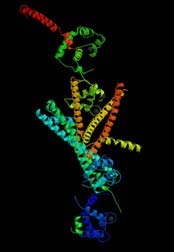New Standard to Help Diagnose Heart Attacks

crystal structure of the human protein cardiac troponin. <br>Graphic Courtesy Protein Data Bank
Diagnosing heart attacks will become a more precise science thanks to the first of a new series of clinical standards just issued by the National Institute of Standards and Technology (NIST). Standard Reference Material (SRM) 2921 (human cardiac troponin complex) will help manufacturers develop and calibrate assays that measure specific protein concentrations in patient blood samples to determine whether a heart attack has occurred.
The SRM is a solution containing certified concentrations of three related proteins, including cardiac troponin I, purified from human heart tissue from cadavers. Users can calibrate their assays by analyzing the SRM and comparing the results to the NIST-certified value for troponin I. The standard is expected to help reduce variations in clinical test results from as much as 50-fold on the same sample to just twofold. “It’s a big first step toward getting the system under control,” says Michael Welch, leader of the NIST development team.
NIST already produces more than 60 SRMs for the clinical diagnostics community, but this is the first one designed to help measure concentrations of large, protein-based health status markers. Troponin I is difficult to measure because it can exist in low concentrations and in different chemical forms, sometimes attached to other related proteins. NIST is developing additional standards and methods for measuring other health status indicators of this type, including hormones used to assess thyroid function, and other markers for heart attack risk such as homocysteine and C-reactive protein.
SRM 2921 is intended to help U.S. makers of in vitro diagnostic (IVD) medical devices sell their products in Europe. A European Union directive requires that such devices be calibrated with standards that are traceable to internationally recognized certified reference materials or procedures. SRM 2921 has been nominated for inclusion on the international list of higher order reference materials. The list currently contains approximately 150 entries for 96 health status markers; NIST SRMs provide traceability for 72 of these.
Media Contact
More Information:
http://www.nist.gov/public_affairs/techbeat/tb2004_0524.htmAll latest news from the category: Health and Medicine
This subject area encompasses research and studies in the field of human medicine.
Among the wide-ranging list of topics covered here are anesthesiology, anatomy, surgery, human genetics, hygiene and environmental medicine, internal medicine, neurology, pharmacology, physiology, urology and dental medicine.
Newest articles

A universal framework for spatial biology
SpatialData is a freely accessible tool to unify and integrate data from different omics technologies accounting for spatial information, which can provide holistic insights into health and disease. Biological processes…

How complex biological processes arise
A $20 million grant from the U.S. National Science Foundation (NSF) will support the establishment and operation of the National Synthesis Center for Emergence in the Molecular and Cellular Sciences (NCEMS) at…

Airborne single-photon lidar system achieves high-resolution 3D imaging
Compact, low-power system opens doors for photon-efficient drone and satellite-based environmental monitoring and mapping. Researchers have developed a compact and lightweight single-photon airborne lidar system that can acquire high-resolution 3D…





















